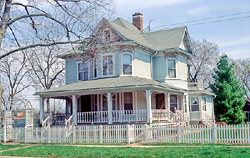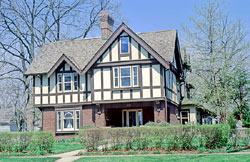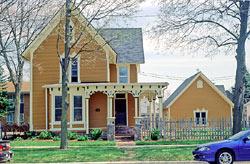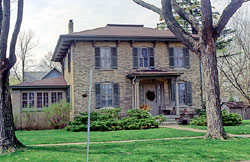Generally bounded by North, Cook, Main, and Maxwell streets
| Historic Name: | Maple Park Historic District |
|---|---|
| Reference Number: | 05000621 |
| Location (Address): | Generally bounded by North, Cook, Main, and Maxwell streets |
|---|---|
| County: | Walworth |
| City/Village: | Lake Geneva |
| Township: |
| Maple Park Historic District Roughly bounded by North, Cook, Main, and Maxwell streets Lake Geneva, Walworth County Construction dates of contributing buildings: 1847-1954 Three sites from Lake Geneva's 1837 original plat are still extant in the Maple Park Historic District: the Pioneer Cemetery, Maple Park, and the Central School site. Surrounding these sites are houses that reflect the development of the city's finest residential architecture from the mid-nineteenth to the mid-twentieth century. The earliest houses of the district are constructed in the Greek Revival and Italianate styles and date from the time when the neighborhood was established by middle and upper middle class families who were active in the community's growth and development. After the Civil War, Geneva Lake emerged as a summer retreat for wealthy Chicago families. This development boosted the growth of the city and fostered the construction of larger, more elaborate houses in the Maple Park neighborhood. Chicago residents were largely behind the construction of the Episcopal Church, designed by Chicago architects Treat and Foltz and built 1880-82 by Austin Moody, a builder of many of the lake estates. The Maple Park neighborhood became the most prominent residential area, with buildings designed by prominent architects. Noted local builder Charles O. LaSalle built several of the Queen Anne style houses, including his own residence in 1893. Charles LaSalle also built old Central School in 1904, designed by important school designers Van Ryn and de Gelleke of Milwaukee. A Prairie School-influenced addition to the Central School was added in 1928-29 and designed by the Chicago firm of J. C. Llewellyn & Co. In 1912, noted Chicago Prairie School architect Robert Spencer designed the Arts and Crafts style Horticultural Hall, which was built by important local builders Reinert, Malsch & Baumbach. A Lustron House, a rare example of a post-World War II attempt to provide mass-produced housing, was built around 1950. And, in 1954, James Dresser, a student of Frank Lloyd Wright, designed the Lake Geneva Library. From the pioneer era through the Chicago-influenced late nineteenth and early twentieth centuries, to the modernism of the 1950s, the Maple Park Historic District is a treasure-trove of Wisconsin architecture.
|
| Period of Significance: | 1847-1954 |
|---|---|
| Area of Significance: | Architecture |
| Applicable Criteria: | Architecture/Engineering |
| Historic Use: | Education: School |
| Historic Use: | Domestic: Single Dwelling |
| Historic Use: | Religion: Religious Facility |
| Architectural Style: | Gothic Revival |
| Architectural Style: | Greek Revival |
| Architectural Style: | Italianate |
| Architectural Style: | Queen Anne |
| Architectural Style: | Tudor Revival |
| Resource Type: | District |
| Architect: | Van Ryn and de Gelke |
| Architect: | Spencer and Powers |
| Historic Status: | Listed in the National Register |
|---|---|
| Historic Status: | Listed in the State Register |
| National Register Listing Date: | 06/17/2005 |
| State Register Listing Date: | 01/21/2005 |
| Number of Contributing Buildings: | 143 |
|---|---|
| Number of Contributing Sites: | 3 |
| Number of Contributing Structures: | 0 |
| Number of Contributing Objects: | 0 |
| Number of Non-Contributing Buildings: | 32 |
| Number of Non-Contributing Sites: | 0 |
| Number of Non-Contributing Structures: | 0 |
| Number of Non-Contributing Objects: | 0 |
| National Register and State Register of Historic Places, State Historic Preservation Office, Wisconsin Historical Society, Madison, Wisconsin |





